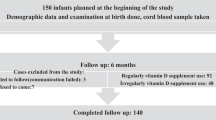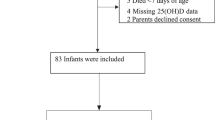Abstract
Vitamin B12 deficiency can lead to serious haematological and neurological signs in infants. The reported clinical cases of vitamin B12 deficiency were found in exclusively breast-fed infants whose asymptomatic mothers were diagnosed later with pernicious anaemia. For the infants, the diagnosis required urinary methylmalonic acid quantification (grossly elevated in these two cases) and treatment rapidly improved the clinical signs. These cases underline the serious consequences of vitamin B12 deficiency in infants and the helpful role of early methylmalonic acid quantification for diagnosis.
Similar content being viewed by others
Introduction
Vitamin B12 has numerous biological functions and is essential for haematopoiesis and nervous system development. Nutritional deficiencies and, among them, vitamin B12 deficiency found in breastfeeding mothers can lead to serious clinical signs in their infants.
Case 1
The first patient was a 3.5-month-old girl suffering from peripheral and axial hypotonia, poor eye contact but no head bobbing at admission and failure to thrive since 2 months of age (Table 1).
Pregnancy and delivery were normal (weight 3050 g). She has two healthy brothers. From birth, she was hypotonic and had mucocutaneous pallor. She was exclusively breast-fed.
Laboratory tests showed aregenerative macrocytic anaemia (haemoglobin=62 g/l) and neutropenia. Further investigations with bone marrow examination showed abnormalities (dysmorphic granulocytic series (band neutrophils, nuclear maturation asynchronism, giant metamyelocytes), megaloblastic erythroblastic series (maturation asynchronism, karyorrhexis), increased number of megakaryocytes (numerous nuclear lobes, granular cytoplasm with abundant platelets)) being suggestive of vitamin B12 or B9 deficiency. Metabolic investigations highlighted methylmalonic acid (MMA) excretion and hyperhomocysteinaemia. Vitamin B12 was not quantified before blood transfusion.
She received blood to correct haemoglobin to 102 g/l. B12 administration (intramuscular injection of hydroxycobalamin as a cobalamin C metabolism disorder was first suspected) improved neurological signs: tone was enhanced, breastfeeding was easier. Moreover, as a complement to breast milk, artificial milk was given to improve weight gain (380 g over 10 days). Finally, blood cell count showed stable regenerative anaemia with haemoglobin at 90 g/l and reticulocytes at 200 G/l and no more neutropenia (Table 1).
Case 2
The second patient was an 8-month-old boy suffering from vomiting, mucocutaneous pallor and hepatosplenomegaly.
Pregnancy and delivery were normal (weight 3300 g). He has one healthy brother. He was exclusively breast-fed and refused food diversification. He had been pale and tired since 1 month of age according to his parents, with failure to thrive at 4 months of age.
Laboratory tests showed aregenerative normocytic anaemia (haemoglobin=73 g/l), neutropenia and thrombocytopenia. Further investigations with bone marrow examination (as leukaemia was suspected) showed abnormalities (poor sample without megakaryocytes, few granulocytic series, cells essentially represented by lymphocytic series and dysmorphic erythroblastic series (maturation asynchronism, multinucleation, abnormal nuclear shapes)) being suggestive of vitamin B12 or B9 deficiency. Metabolic investigations showed MMA excretion and hyperhomocysteinaemia. Vitamin B12 was decreased (67 pg/ml; reference range 211–911 pg/ml) and vitamin B9 was normal.
He received blood and platelets. B12 administration (intramuscular injection of cyanocobalamin) improved his biological signs: regenerative anaemia with haemoglobin at 96 g/l and reticulocytes at 325 G/l, no more neutropenia and enhanced thrombocytes (83 G/l). At the same time, artificial milk and food diversification were introduced to improve weight gain (500 g over 10 days; Table 1).
In both cases, maternal investigations were performed just after vitamin B12 deficiency diagnosis in their infants. Both mothers had vitamin B12 deficiency (125 and 137 pg/ml, respectively). Nutritional investigation showed no input deficiency. Immunological analysis showed anti-intrinsic factor and anti-parietal cell antibodies and confirmed pernicious anaemia. Both mothers have now been treated with vitamin B12.
Discussion
We report here two cases of children with serious haematological and neurological signs for which aetiological investigation indicated vitamin B12 deficiency in their mothers.
The only source of dietary vitamin B12 in breast-fed infants is maternal milk. Cobalamin (vitamin B12) is present in animal foods, eggs and dairy products.1
Therefore, breast-fed infants of mothers with vitamin B12 deficiency (vegetarians and vegans without B12 supplementation, intestinal diseases such as Crohn’s or coeliac disease, pernicious anaemia) may be at high risk of vitamin B12 deficiency. Interestingly, for adults, clinical impairment resulting from such a deficiency develops slowly over months or years. This contrasts with infants for whom the impact is severe in only a few weeks.2 Prospective studies have provided some evidence that prenatal and postnatal vitamin B12 deficiency may be negatively related to child development.3 Typical manifestations are failure of brain development, developmental regression, hypotonia, feeding difficulties, lethargy, tremors, hyperirritability and coma.4 Early detection and treatment of cobalamin deficiency is important to prevent cognitive decline and neuropsychiatric disorders. Thus, considering that the commonest cause of vitamin B12 deficiency in breast-fed infants is maternal veganism, in such circumstances, after a nutrition and a personal dysimmunity context history survey, maternal intrinsic factor and parietal cell antibody measurement should be performed to exclude maternal pernicious anaemia.5 As MMA is excreted as carnitine esters, patients may also need short-term carnitine supplementation.
The laboratory examinations we conducted concerning these two patients included plasma cobalamin and urinary MMA measurement. Measurement of cobalamin is commonly used to screen for cobalamin deficiency but there are many falsely low (pregnancy, oral contraceptives) and falsely high (renal failure, hepatic disorders, blood transfusion) values.6 Concerning homocysteine, many genetic, acquired or environmental factors elevate its levels.6 Thus, plasma total homocysteine is less specific than MMA quantification for the diagnosis of cobalamin deficiency6 but its measurement is essential in the differential diagnosis of elevated MMA levels.7 In one step of metabolism, vitamin B12 promotes conversion of methylmalonyl-CoA to succinyl-CoA.6 MMA is necessary for human metabolism and energy production but its excretion is normally very low. If there is not enough vitamin B12 available, then MMA concentration begins to rise, resulting in an increase of MMA in blood and urine. The mass spectrometry measurement procedure used for MMA quantification is fast, sensitive and specific. In a clinical study, all but 1 patient in 40 breast-fed infants with nutritional vitamin B12 deficiency had methylmalonic aciduria.2 In fact, two causes of elevated MMA in urine are now well known: genetic disorders and non-genetic disorders, the second being represented by nutritional deficiencies. On one hand, measurement of MMA and related metabolites in urine (3-hydroxypropionate, methylcitrate, homocystine) provides a reliable first-line diagnosis approach in patients suspected of an inborn error of metabolism. On the other hand, measurement of elevated amounts of MMA in blood or urine serves as a sensitive and early indicator of vitamin B12 deficiency. Moreover, urinary MMA excretion is generally grossly elevated in genetic disorders compared with nutritional deficiencies.7 The relationship between MMA and vitamin B12 has been known for over 40 years,8 but the use of MMA testing is not widespread nor is there agreement on its clinical utility. Thus, raised urinary MMA and plasma homocysteine levels are important early features of vitamin B12 deficiency when other lab features are normal.
In conclusion, with these case reports, we would like to make clinicians aware of the serious irreversible consequences of vitamin B12 deficiency in exclusively breast-fed infants and of the importance of MMA quantification, which can be of assistance in such circumstances.
References
Pawlak R, Parrott SJ, Raj S, Cullum-Dugan D, Lucus D . How prevalent is vitamin B12 deficiency among vegetarians? Nutr Rev 2013; 71: 110–117.
Honzik T, Adamovicova M, Smolka V, Magner M, Hruba E, Zeman J . Clinical presentation and metabolic consequences in 40 breastfed infants with nutritional vitamin B12 deficiency—what have we learned? Eur J Paediatr Neurol 2010; 14: 488–495.
Pepper MR, Black MM . B12 in fetal development. Semin Cell Dev Biol 2011; 22: 619–623.
Stabler SP . Clinical practice. Vitamin B12 deficiency. N Engl J Med 2013; 368: 149–160.
Mathey C, Di Marco JN, Poujol A, Cournelle MA, Brevaut V, Livet MO et al. [Failure to thrive and psychomotor regression revealing vitamin B12 deficiency in 3 infants]. Arch Pediatr 2007; 14: 467–471.
Solomon LR . Disorders of cobalamin (vitamin B12) metabolism: emerging concepts in pathophysiology, diagnosis and treatment. Blood Rev 2007; 21: 113–130.
Fowler B, Leonard JV, Baumgartner MR . Causes of and diagnostic approach to methylmalonic acidurias. J Inherit Metab Dis 2008; 31: 350–360.
Norman EJ, Martelo OJ, Denton MD . Cobalamin (vitamin B12) deficiency detection by urinary methylmalonic acid quantitation. Blood 1982; 59: 1128–1131.
Author information
Authors and Affiliations
Corresponding author
Ethics declarations
Competing interests
The authors declare no conflict of interest.
Rights and permissions
About this article
Cite this article
Van Noolen, L., Nguyen-Morel, M., Faure, P. et al. Don’t forget methylmalonic acid quantification in symptomatic exclusively breast-fed infants. Eur J Clin Nutr 68, 941–942 (2014). https://doi.org/10.1038/ejcn.2014.69
Received:
Revised:
Accepted:
Published:
Issue Date:
DOI: https://doi.org/10.1038/ejcn.2014.69


